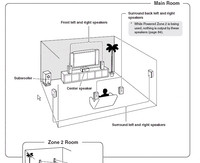Abhilash:
To add to what Psychotropic has been advising you, I just want to clear some confusion in terms of the terminology used for the AVR speakers.

Look at the picture above. The two speakers immediately to the left and right of the TV are the FRONT Left and Right speakers, sometimes called Front L&R, which play the Front Channels. You can connect a floor stander or a bookshelf to these channels. The general rule is that the top most driver in the speaker (usually a tweeter) is at the same level as your ears in your regular sitting position.
The speaker just below the middle of the TV plays the CENTRE Channel. These are special speakers that are horizontal in shape and have two mid range drivers (or woofers) in the two edges with a tweeter in the middle. This is usually placed immediately below the TV.
The slightly largish speaker standing on the floor to the left of the TV is the sub woofer that plays the SUB WOOFER or the Point 1 LFE channel. Sub woofers are of two types ?? active and passive. Active sub woofers have their own amplifier inside, and these are used for the Point 1 LFE channel. Passive sub woofers need external amplification, and may need a Bass Management System.
If you move further towards the viewer, you will find two speakers on his left and right. These speakers are connected to the SURROUND Left and Right channels. These speakers are usually mounted on the wall some 3 feet above your seated ear position. There are two types of speakers that can be used for this. One is the standard bookshelf speaker. Some brands also call them surround speakers. The other type is called dipole speakers.
The best surround sound can be achieved by using dipole speakers for SURROUND sound channels. Dipole speakers have three or five faces in the front, the largest side faces being at an angle instead of being perpendicular to the rear face. The faces have drivers mounted on them. Sound is radiated both forward and backward producing a sound field that blends in with the front speakers while using the reflection of the rear walls to produce an ambient sound field behind you. None of the drivers face your listening position so you won??t hear the speaker's location.
The layout we discussed till now is called 5.1. There are some people who believe the SURROUND sound speakers should be behind the viewer. Though there is no harm in doing that, the way DTS and Dolby Digital encode signals, the surround sound is supposed to come from your side, not your rear.
This takes us to the speaker behind the viewer. Now look at the room layout again. You will find two more speakers directly
behind the viewer. These are usually in line with the front speakers. These play the SURROUND BACK Left and Right channels. You need a 7.1 AVR to drive these speakers.
But if you using a 5.1 system, irrespective of where you place the SURROUND L&R,
do not leave the SURROUND L&R disconnected and the SURROUND BACK L&R connected. You will not get any sound at all then.
Some AVRs such as the Onkyo 506 allow you to bi-amp the FRONT Speakers using the connections of the SURROUND BACK L&R. but for this your FRONT speakers must have bi-amping capabilities. There is
no harm is leaving the SURROUND BACK channels disconnected when you have a 5.1 set up.
Cheers


